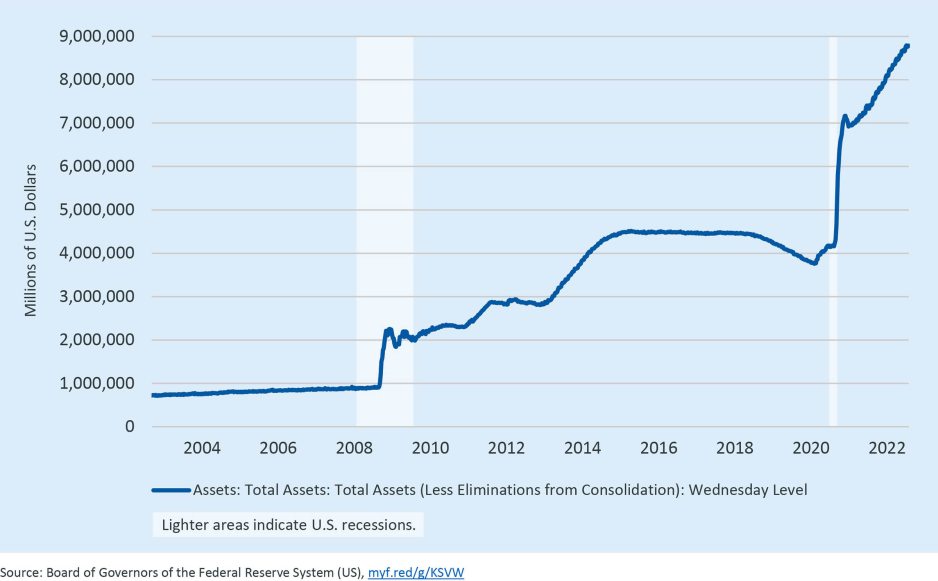
In the early days of COVID, The Wall Street Journal published an opinion piece by Allison Schrager that has stayed with us throughout the pandemic. Schrager built her essay on the distinction between risk and uncertainty. “The future is unknowable, but risk is measurable,” she wrote. “It can be estimated using data, provided similar situations have happened before. Uncertainty, on the other hand, deals with outcomes we can’t predict or never saw coming.”
From Uncertainty to Risk
Schrager’s essay has resonated over the past two years as we have lived through a stream of “never saw that coming” events. We make it through one wave of the pandemic and relax our guard a bit, then experience another wave propelled by a mutated virus that has us recalculating the adequacy of our face masks. We watch as figures for the national debt and the Federal Reserve’s balance sheet climb to levels never seen before. We experience spikes in inflation—driven by stimulus-fueled spending chasing too few supply-chain-disrupted goods—and debate whether this is a transitory or structural phenomenon. We wonder whether we should be looking for a return to a pre-pandemic “normal” or a post-pandemic landing spot that has yet to be identified. Uncertainty has been dominant since March 2020, and as Schrager notes in her essay, “Managing uncertainty is expensive: In markets, it means holding cash; in society, it means shutting down” (emphasis added).
Despite our current encounter with the Omicron variant, we anticipate that we have already started the transition from uncertainty back to risk as we become more accustomed to the rhythms of the pandemic. Even though infection rates from the Omicron variant are at the highest level of the pandemic, for example, we seem to be a moving from a “shut it down” mentality to a “let’s learn to live with this” mindset. In the markets, the rush for liquidity that characterized the “crisis” phase of the pandemic has eased, and the Fed is moderating balance sheet growth and positioning us for higher interest rates to combat inflation that no longer appears transitory.
The Income Statement/Balance Sheet Dynamic
Since the pandemic began, we have predicted that it would move through three phases: from crisis (a monetary event) to stabilization (a credit event) to normalization. If we are moving into the stabilization phase, we will be coming to terms with the financial and credit implications of the crisis response over the year to come, and probably for some time after.
The dynamic between the income statement and the balance sheet has been and will remain incredibly important for hospitals and health systems through the crisis and stabilization phases of the pandemic. While income statements have been buffeted by the pandemic’s operational disruptions and, more recently, escalating expenses, balance sheet strength has served as a resiliency anchor that has helped organizations manage their credit profile.
If we look at this dynamic within an uncertainty-to-risk continuum, the income statement (i.e., operations) has a clearer view of risk, and the biggest long-term risk is that expenses have permanently reset higher while revenues are volatile and may not keep pace.
On the expense side, while some costs may go back down, labor costs—the most significant driver of operating expense—have likely undergone a structural change, with wages reset at higher levels. On the revenue side, volumes remain soft and any gains in revenue are being outpaced by rising expenses, which are compressing operating margins. Birth rates are declining, the population is aging, and payer mix continues to shift away from commercial plans toward Medicare and Medicaid. With the national debt approaching $30 trillion, it seems inevitable that something will have to give, whether that be in the form of a “Balanced Budget Act Two” or some other legislative or regulatory intervention to control spending. This seems unimaginable after years of massive federal spending, but it also feels like we have reached a place where a jarring hard stop is as likely as a smoothly managed spending slowdown.
From the balance sheet perspective, the view is more fogged by lingering uncertainty. With few exceptions, the Fed has maintained an accommodative monetary policy since the Great Recession of 2008 – 09, and that policy intensified dramatically over the first two years of the pandemic: The Fed’s balance sheet more than doubled from $4.3 trillion on March 11, 2020, to almost $8.8 trillion as of January 19, 2022. With stabilization will come the need to unwind the massive amounts of liquidity the Fed has pumped into the system, and we have no experience with how an effort of that scale will affect the markets.
Figure 1: Growth in the Federal Reserve’s Balance Sheet

The worst-case scenario is that the income statement remains under stress and the balance sheet comes under pressure in response to monetary policy tightening and rising interest rates. The success determinants in every scenario are grounded in figuring out the uncertainty-to-risk continuum across the enterprise and how to manage the long slog to a new normal.
How Hospitals and Health Systems Should Respond
As we move into the stabilization phase of the pandemic, hospital and health system leaders should consider the following:
- Double down on improving operational performance. We anticipate a “back to the basics” emphasis on true credit fundamentals in the year ahead, with a renewed emphasis on improving operations. What are your organization’s strategies for revenue management? What is the organization doing to mitigate the impact of rising labor costs? What is the story behind the numbers you will be sharing with your board or reviewing with your rating analyst, and what are the next chapters in that story?
- Revisit the positioning of all real resources, including cash, invested assets, real estate portfolios, and other “non-core” or monetizable assets/operations. Are operating cash balances appropriately sized and coordinated with other liquidity resources (e.g., lines of credit, invested assets, and other leverage tools)? Are invested assets properly deployed along a “promote resiliency-driven return” continuum? Is the organization’s real estate portfolio optimally aligned with strategic, operational, and financial objectives and needs? Are there operations or assets that can be converted from their current configuration into a more useful form of financial resource?
- Take advantage of current market conditions to de-risk the debt portfolio. Notwithstanding an upward shift in long rates and steepening curves, as 2022 begins, opportunities for de-risking remain with low rates, relatively flat curves, and support for issuing long duration natural fixed debt. Capital structure remains one of the few parts of the enterprise where it is possible to offload risk at a reasonable cost. This will change as rates move higher or if markets become more volatile in response to transitioning Fed policies.
- Emphasize strategic risk management. Move beyond compliance-driven enterprise risk management efforts to identify and quantify the subset of risks that represents the major financial headwinds your organization confronts across operations, strategy, capital, and liabilities. The idea is to generate a tailored risk map unique to your organization that can be an adaptable guide as we move through what might be a bumpy stabilization phase.
- Extend your organization’s focus on building resiliency. We expect to encounter turbulence as we move through the stabilization phase. Over the past year, we have emphasized the need to pay attention to resiliency, ensuring that your organization’s risks and resources are in balance. The risks organizations face will keep shifting, and to the extent volatility enters the markets, so too will the resources your organization can draw upon. The need for organizational resiliency, however, will remain a constant theme.
- Make sure that your organization has an integrated resource allocation framework in place. While resiliency remains key, returns are important as well. Across every healthcare organization is a collection of diversified economic activities, each of which has a different resource vs. risk profile and resiliency vs. return impact. Both are necessary, and we have found that an integrated resource allocation framework is the best tool for finding the balance point that makes sense for your organization and for discerning how specific opportunities fit into the bigger picture.
This has been a long two years, and we hope that our prediction of stabilization in 2022 is correct. We welcome the opportunity to discuss any concerns or ideas with you as we move through the year ahead.









